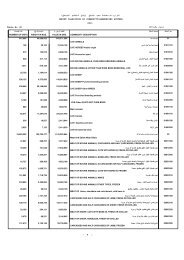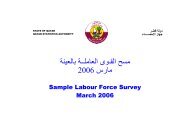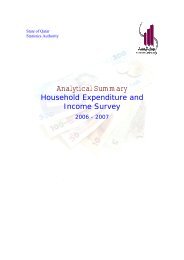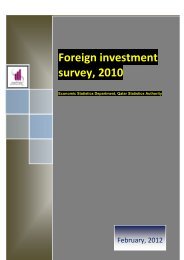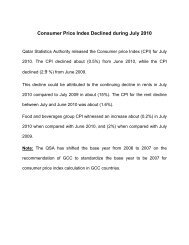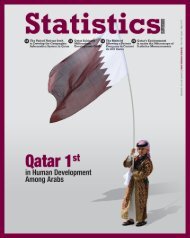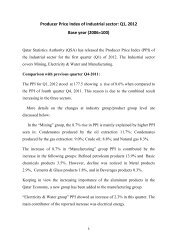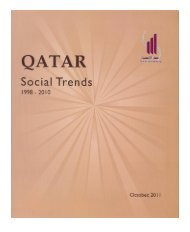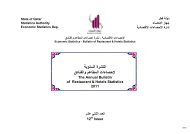(Microsoft PowerPoint - 2_GSDP QSA Waste Training Workshop ...
(Microsoft PowerPoint - 2_GSDP QSA Waste Training Workshop ...
(Microsoft PowerPoint - 2_GSDP QSA Waste Training Workshop ...
Create successful ePaper yourself
Turn your PDF publications into a flip-book with our unique Google optimized e-Paper software.
QNV 2030 / NDS 2011-2016 – Managing and Monitoring Outcomes and Goals (<strong>Waste</strong> Management)<br />
Managing and Monitoring<br />
National Development Strategy 2011-2016 Outcomes<br />
& Qatar National Vision 2030 Goals<br />
Reduced waste, more recycling<br />
and more efficient use<br />
Sharon Ng<br />
Department of Social Development<br />
General Secretariat for Development Planning<br />
Doha<br />
May 2012<br />
<strong>QSA</strong> <strong>Waste</strong> Statistics <strong>Training</strong> <strong>Workshop</strong>, Doha<br />
18 June 2013
QNV 2030 / NDS 2011-2016 – Managing and Monitoring Outcomes and Goals (<strong>Waste</strong> Management)<br />
Presentation Themes<br />
1<br />
2<br />
3<br />
4<br />
5<br />
6<br />
Context – Qatar and Sustainable Development<br />
NDS 2011-2016 Mid-term Review (MTR) 2013<br />
NDS 2011-2016 Outcomes and Targets for <strong>Waste</strong><br />
Management<br />
Progress, Challenges and Responses for <strong>Waste</strong><br />
Management<br />
A Sustainable <strong>Waste</strong> Management System - Requires<br />
Thinking, Working and Accurate Data Across the<br />
Value Chain<br />
Conclusions
1<br />
QNV 2030 / NDS 2011-2016 – Managing and Monitoring Outcomes and Goals (<strong>Waste</strong> Management)<br />
Qatar’s GDP and Population Grew Unsustainably<br />
Between 2000 and 2010<br />
and will continue to grow rapidly towards 2022<br />
Exceptionally rapid rise in population, average 15% a year between 2004-08 and economic growth at its<br />
peak, called for a vision and strategic planning. Continuing rapid population and development till 2022<br />
requires plans to address new and emerging national development priorities<br />
(%) (%)<br />
25<br />
25<br />
GDP Growth (%, 3-year<br />
moving average, 2004 prices)<br />
20<br />
15<br />
10<br />
5<br />
5.6<br />
6.5<br />
4.9<br />
10.0 10.1<br />
17.6 17.2<br />
20.6<br />
15.9 15.5<br />
13.9<br />
12.0<br />
9.6<br />
20<br />
15<br />
10<br />
5<br />
Population growth<br />
0<br />
00 01 02 03 04 05 06 07 08 09 2010 2011 2012<br />
0<br />
GDP Growth<br />
Population Growth
QNV 2030 / NDS 2011-2016 – Managing and Monitoring Outcomes and Goals (<strong>Waste</strong> Management)<br />
Need for Sustainable Environmental Management<br />
Balancing rapid economic and population growth with environment<br />
Qatar’s growing urban population, rising per capita income and rapid economic<br />
growth affecting the environment<br />
Increasing per<br />
capita Income<br />
Rapid<br />
population<br />
growth<br />
Increasing<br />
impact on<br />
Qatar’s<br />
environment<br />
Environmental<br />
impact per $<br />
of income<br />
To meet this challenge<br />
requires<br />
Comprehensive environmental management system that<br />
aligns national growth and prosperity to realities of<br />
environmental constraints, supported by increasing capacity<br />
and sustainable technologies
2<br />
QNV 2030 / NDS 2011-2016 – Managing and Monitoring Outcomes and Goals (<strong>Waste</strong> Management)<br />
NDS Mid-term Review 2013<br />
Measuring progress towards QNV Goals and NDS Outcomes<br />
<br />
<br />
<br />
To take stock of NDS progress in relation to extent:<br />
– to which sector strategy outputs have been achieved<br />
– of progress towards NDS outcomes and whether they remain<br />
relevant and are achievable by 2016<br />
– to which project implementation has developed capacities of<br />
ministries and agencies<br />
– to which inter-sectoral partnerships have functioned as expected<br />
and value of collaboration between implementing agencies and<br />
<strong>GSDP</strong><br />
– of external and internal risk to attaining NDS outcomes<br />
To make mid-term corrections and adjustments based on<br />
the stock taking<br />
To align new and emerging national development<br />
priorities, especially in relation to global context
3<br />
QNV 2030 / NDS 2011-2016 – Managing and Monitoring Outcomes and Goals (<strong>Waste</strong> Management)<br />
NDS 2011-2016 Solid <strong>Waste</strong> Management<br />
Targets and Outcome<br />
Project Targets to be Achieved by 2016 Outcome<br />
<br />
Establish a solid waste<br />
management plan, strongly<br />
emphasizing recycling<br />
Establishing a<br />
solid waste<br />
management<br />
plan<br />
<br />
<br />
Recycle 38% of solid waste, up<br />
from the current 8%<br />
Contain domestic waste<br />
generation at 1.6 kilogrammes<br />
per capita per day<br />
Reduced <strong>Waste</strong>,<br />
More Recycling<br />
and<br />
More Efficient<br />
Use
QNV 2030 / NDS 2011-2016 – Managing and Monitoring Outcomes and Goals (<strong>Waste</strong> Management)<br />
The Domestic Solid <strong>Waste</strong> Management Centre (DSWMC)<br />
Instrumental in achieving NDS targets for solid waste management<br />
Qatar’s waste management plan includes source separation and material recovery to<br />
increase recycling to 38%, reduce landfill to 53% and convert waste to energy
4<br />
QNV 2030 / NDS 2011-2016 – Managing and Monitoring Outcomes and Goals (<strong>Waste</strong> Management)<br />
Preliminary Updated Data for Solid <strong>Waste</strong> in 2012<br />
Highlights need for NDS mid-term corrections and new solutions<br />
<br />
<br />
Qatar’s domestic waste collected exceeds daily capacity of the DSWMC<br />
Recycling while increasing, remains low as a percentage of total waste<br />
<strong>Waste</strong> generated<br />
2012<br />
7,300 tonnes per day<br />
Recycling<br />
2012<br />
63%<br />
nondomestic<br />
4,600 tonnes<br />
per day<br />
Recycling of<br />
nondomestic<br />
waste<br />
% to be<br />
confirmed<br />
37%<br />
domestic<br />
2,700 tonnes<br />
per day<br />
Recycling of<br />
domestic<br />
waste<br />
1.3% of total<br />
at DSWMC
QNV 2030 / NDS 2011-2016 – Managing and Monitoring Outcomes and Goals (<strong>Waste</strong> Management)<br />
Progress and Challenges<br />
Daily municipal household waste, recycled waste and hazardous waste<br />
<br />
<br />
<br />
Daily municipal household waste per capita at 1.45 kg/capita/day in 2012 within NDS target<br />
of 1.6 kg/capita/day but increasing.<br />
Volume of recycled waste has increased, from 2001 to 2008, but remains low as a<br />
percentage of total waste, less than 1%. Data a challenge<br />
Hazardous waste increasing gradually. Data a challenge<br />
Hazardous waste (kg/unit of GDP)<br />
35<br />
30<br />
25<br />
20<br />
15<br />
10<br />
5<br />
0<br />
31.9<br />
27.9<br />
21.2<br />
12.7<br />
2005 2006 2007 2008
QNV 2030 / NDS 2011-2016 – Managing and Monitoring Outcomes and Goals (<strong>Waste</strong> Management)<br />
Progress and Challenges<br />
Qatar’s non-municipal industrial/construction waste forms a large<br />
and increasing proportion of total solid waste<br />
Responses: Plans to develop a Construction and Demolition <strong>Waste</strong> facility<br />
Plant to recycle tyres for multiple uses including additive to roads<br />
Study on innovative use of recycling construction materials<br />
14<br />
Total wastes (million metric tonnes)<br />
12<br />
10<br />
8<br />
6<br />
4<br />
2<br />
0.74<br />
2.15<br />
5.37<br />
0.78<br />
2.24<br />
7.72<br />
0.85<br />
0.82 0.87<br />
2.69 2.25 2.15<br />
8.86 9.10 9.23<br />
Municipal Domestic a<br />
Municipal Industrial b<br />
Non-Municipal<br />
Industrial/<br />
Construction<br />
0<br />
2008 2009 2010 2011 2012
6<br />
QNV 2030 / NDS 2011-2016 – Managing and Monitoring Outcomes and Goals (<strong>Waste</strong> Management)<br />
Conclusions<br />
<br />
NDS MTR 2013 will review NDS targets and outcomes for waste and<br />
address new and emerging national development priorities<br />
<br />
Data on waste to support robust evidence based policy and regulatory<br />
considerations for waste management is still a challenge<br />
<br />
Government working in multiple partnership for sustainable waste<br />
management through investments in education, cutting-edge research,<br />
frontier technologies and capacity building<br />
<br />
Raising awareness of Qatar’s population on the importance of reducing<br />
waste and increasing recycling to protect the environment and maintain<br />
quality of life<br />
<br />
Promote new patterns in consumption and production



